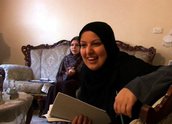


Temple of Dreams (2007)
Synopsis
Fadi Rahman runs the self-funded ICRA Youth Centre, operating out of a converted Masonic Temple in the heart of Sydney’s Muslim community. When the Cronulla riots take place in December 2005, Fadi realises the need to accelerate and increase the programmes for Muslim youth made possible by ICRA. In the meantime, the local council has ruled that the location of the Youth Centre contravenes zoning regulations. The film follows Fadi and his team of dedicated volunteers for over 18 months. A couple of ambitious youth projects are successfully realised, while in the background the fight to retain the Centre’s premises goes on.
Curator’s notes
One of the problems for a cash-strapped documentary industry, like that in Australia, is the lack of opportunity for directors to gain extensive experience and consolidate their filmmaking practice. One exception is Tom Zubrycki, who has been making documentaries for over 25 years. When Zubrycki began his career, documentary filmmakers were still wrestling with the notion of voice-over and narration subjectivity, and arguing the difference between verité and direct cinema. Zubrycki saw out these debates, making films consistently throughout the documentary distribution doldrums of the 1990s, followed by the new century’s box office success phenomenon and the onslaught of reality TV. Over the period he developed a distinctive, relaxed observational style. The time spent with his subjects – both observing and filming – is clearly evident. While there’s no attempt to conceal the presence of the film crew, its exposure is without contrivance. The narration, spoken by Zubrycki and occurring only in explanatory snippets, gently nudges the narrative and lightly accentuates issues and sensibilities.
Temple of Dreams owes its success to this well-honed approach, to the characteristically perceptive editing of Ray Thomas (with whom Zubrycki usually works) and to Zubrycki’s track record – which gained him access to an understandably media-shy community. Zubrycki selected the disadvantaged and disaffected youth in Sydney’s Muslim community as his subject matter soon after the London bombings in 2005. He came across the vibrant Fadi Rahman and the volunteers at the ICRA Youth Centre. Fadi had been a Muslim youth advocate for some time, but when the Cronulla riots broke out, a month or so after Zubrycki began filming, the mainstream media suddenly became interested, descending on ICRA and interviewing Fadi as if he were the negotiator for a rebel colony. In the aftermath, Fadi and the other volunteers realised the critical nature and the urgency of the work ICRA could do.
On and off for over a year, Zubrycki followed Fadi, a human dynamo and born entrepreneur, whose energy and commitment to every project he undertakes would put many of our excessively remunerated corporate CEOs to shame. The difference is that all Fadi’s work, apart from his panelbeating business, is unpaid. And all of it is directed at bettering the lives and improving the self-esteem of the youth in the community around him. Fadi is assisted by a group of equally committed young men and women and we see them embark on two major youth initiatives – the bringing of former rapper Napoleon to Australia, and the organisation of a youth conference.
Running through the centre of the film is another issue – ever-present and unresolved. The temple in the title is an old Masonic Temple, converted by ICRA to a youth centre and incorporating a boxing gymnasium on the upper floor – where trainer Billy Hussein and kickboxing instructor Azzam El Sayed run a tight ship. The local council sees the building’s change of usage as a breach of zoning regulations and wants the centre closed. Earlier waves of first generation Australians and disadvantaged youth were able to pull themselves up, in a country highly governed on a national level and fairly unregulated on a local level. It’s hard to believe that Larry Foley (the leader of a Catholic larrikin gang who gave up sectarian street brawling to take up boxing and establish a gym in Sydney’s George Street in the 1860s) or Jack Rennie (who ran a backyard gym in Melbourne’s Essendon in the 1960s and trained the likes of Lionel Rose) had to submit development applications for their activities. But the way the country’s run has changed, with a far less regulated national economy and highly controlled local administrations. It doesn’t seem fair, and that’s how Fadi sees it too. Right to the end of the film he’s determined to fight for the Centre’s right to stay where it is.
Fadi Rahman was interviewed by Richard Fidler on ABC Radio’s The Conversation Hour in November 2006.
The film premiered at the 2007 Sydney Film Festival and was released on DVD as a 90-minute feature. A 52-minute version was broadcast on SBS on 4 December 2007.
- Overview
- Curator’s notes
- Video 3 clips

- Principal credits
- Find a copy
- Comments 1
- Add your review



